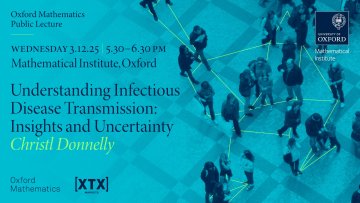Movement of a Sessile Cell Colony
Fowler, A
Winstanley, H
Mathematical Proceedings of the Royal Irish Academy
volume 112
issue 2
79-91
(01 Jan 2012)
Quasi-steady uptake and bacterial community assembly in a mathematical model of soil-phosphorus mobility
Moyles, I
Donohue, J
Fowler, A
(10 Sep 2019)
The development of deep-ocean anoxia in a comprehensive ocean phosphorus model
Donohue, J
Florio, B
Fowler, A
(19 Aug 2020)
How do diseases spread and how can the analysis of data help us stop them? In this lecture, Christl Donnelly will draw lessons from past epidemics and endemic diseases, across livestock, wildlife, and human populations, to show how mathematical frameworks and statistical inference help unravel complex transmission systems. Click the link above for details.
Stability of Inverse Problems for Steady Supersonic Flows Past Lipschitz Perturbed Cones.
Chen, G
Pu, Y
Zhang, Y
Archive for rational mechanics and analysis
volume 249
issue 6
77
(20 Jan 2025)
Sharp Fuss-Catalan thresholds in graph bootstrap percolation
Bartha, Z
Kolesnik, B
Kronenberg, G
Peled, Y
(30 Oct 2025)
Permutation-Invariant Spectral Learning via Dyson Diffusion
Schwarz, T
Dieball, C
Kogler, C
Lam, K
Lambiotte, R
Doucet, A
Godec, A
Deligiannidis, G
(09 Oct 2025)



